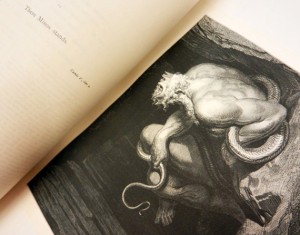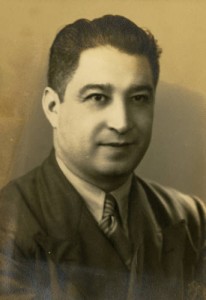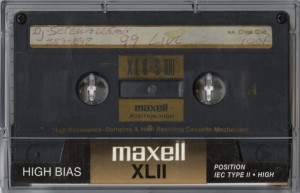
In addition to the over 7,000 linear feet of archival collections made available for study at the University of Houston Special Collections, we are also proud to offer over 100,000 rare and antique books for use in our reading room. Each month (some more dutifully than others) we will highlight a text from our collections and what makes it so special.
In the spring 2015 semester we had the good fortune to host our first-ever UH Special Collections Social Media Intern, Shelby Love. As part of her duties, Love curated a number of selections for our Book of the Month series here on the blog. For this month (and many to come, no doubt) we share a Book of the Month selection from Shelby Love.
Book of the Month: The Vision of Hell by Dante Alighieri, translated by Henry Francis Cary, and illustrated with the designs of M. Gustave Doré.
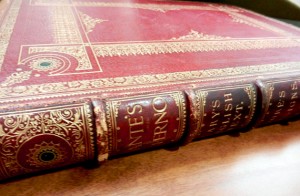
“Abandon all hope, ye who enter here.” The Vision of Hell by Dante Alighieri
Why so Special? In this 1866 edition, Dante Alighieri’s literary masterpiece is skillfully presented through the two archetypal interpretations of Henry Francis Cary and M. Gustave Doré. Cary, a graduate of Christ Church College, Oxford and assistant librarian in the British Museum, translated the Divine Comedy from Italian to English in the early 1800s. Despite the availability of numerous alternative translations, Cary’s version remained the standard into the twentieth century. That would be over 100 years of beating his competitors. In fact, his poetic translation was admired by other literary giants such as Wordsworth, Keats, Lamb, Coleridge, Macaulay, and Ruskin. Cary dedicated countless hours and even his own funds to complete the project for public consumption, truly a meritorious example of just how important our librarians are to society.
The second distinguished interpretation is through Doré’s vivid illustrations of the otherworldly adventure. Doré was an incredibly successful and productive French illustrator and printmaker in the 19th century known for his imaginative and fantastical artwork. His work was mainly centered around themes like the (pessimistic) fate of mankind and meditations on life and death, making him and Dante such a compatible ideological pair, the likes of which even match.com couldn’t hope to recreate. In fact, one contemporary critic found the illustrations to be so conscientious that he suggested Doré and the long deceased Dante were communicating through the occult. Dante enthusiasts and scholars still consider Doré a determiner for how the Divine Comedy is visualized by readers today, ranking his hypnotic renderings along with those of Sandro Botticelli, William Blake, Eugène Delacroix, and even Michael Angelo.
With a detailed red and gold hardcover, this edition is one of the most eye-catching items among our larger-format books. The sheer size of it can strike the modern day book lover as both whimsical and puzzling, eliciting the question, why would such a serious classic need to be so colossal? A rewarding perusal in the reading room will reveal a uniquely intimate way to engage with Dante’s beloved classic as Cary’s poetic translation of the writer’s imaginative vision is presented side by side with Doré’s exquisite renditions of the literary masterpiece. This incredible edition contains the crowning achievements of three fruitful lifetimes, brought together by one vision.
Location: Those interested in consulting with this edition of Dante’s classic may request call number PQ4315.2 .C4 1866 in the Special Collections Reading Room.
The following piece appears courtesy of Dan Johnson, 2013 Mosaic Fellow, wherein he provides a look at a sampling of projects benefiting from his internship with the University of Houston Special Collections.
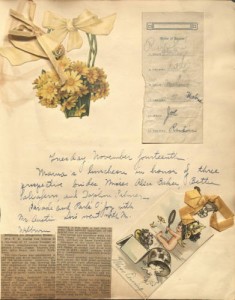
A full dance card (Gladys Ewing’s 1911 Houston Society Scrapbook, The Ewing Family Papers)
I was selected as a Mosaic Fellow in the Fall of 2013 by the Association of Research Libraries and the Society of American Archivists. I’m presently a MSLS student at the University of North Texas, studying Archival Studies and Digital Image Management. The Mosaic Fellowship included an internship component, pairing up fellows with host ARL institutions; I was glad to have the opportunity to intern here at UH Special Collections since September 2014. I’ve since had the pleasure of working on a variety of special projects, working hands on with archival materials.
I first started a digital audit of the Ewing Family Papers, comparing the physical archival collection to its finding aid and existing digital collection. In that review of the Ewing family scrapbooks, I worked with Valerie Prilop, Digital Collections Librarian, and we discovered that the finding aid for one of the scrapbooks provided descriptions for only the front side of each scrapbook page, but did not describe the reverse side, while the digital collection had page-level descriptions for both front and back sides of the pages. Ultimately, we were able to identify places where the finding aid could be improved, and we made some recommendations to combine two digital collections, one per scrapbook, into a single consolidated digital collection, a project for a later date.
I then started a project under the guidance of University Archivist Mary Manning, processing and describing additions to the William C. Moffit Papers. The collection was originally donated by Dr. Moffit himself, but several additions were later donated by his wife and family after he passed away. I was able to process and describe some additional manuscript parts, published musical arrangements, and Patterns of Motion training materials, among other things. Working with a member of the faculty from the School of Music who was intimately familiar with Dr. Moffit’s work helped me better describe and arrange the materials in a way that will make the most sense to researchers using this collection.
I started work on a third project with Hispanic Collections Archivist Lisa Cruces, auditing the physical material of the Alonso S. Perales Papers and comparing the physical archival collection to the finding aid. There were a handful of items in the physical collection that were not reflected in the finding aid, and I have been correcting the finding aid to more faithfully represent the collection.
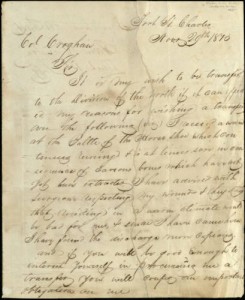
Request for transfer to a unit in the north signed by Sam Houston (November 29, 1813, Early Texas Documents Collection)
Most recently, I’ve been given the opportunity to work with Librarian Emerita Pat Bozeman on a project transcribing and contextualizing some handwritten letters. Two of these items were taken from the Early Texas Documents collection. One item is a letter from Sam Houston written after he was wounded in the Battle of Horseshoe Bend. It documents his request to be transferred from New Orleans to a more northern location upon the advice of several physicians. Another item is a letter that highlights Stephen F. Austin’s efforts to gather support from the United States government and people for Texas Independence and was written in Nashville, Tennessee days before Texas declared independence from Mexico. Working intimately with historical documents such as these has been a very exciting and rewarding experience.
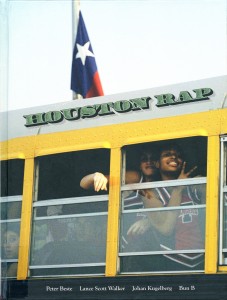
Cover of Houston Rap by Peter Beste and Lance Scott Walker
The newest accession to the Hip Hop collections is the Peter Beste and Lance Scott Walker Houston Rap Collection, and it is one that we here in Special Collections are very excited about! Houston Rap is the joint creation of documentary photographer Peter Beste and writer Lance Scott Walker. The book provides a vivid glimpse into Houston’s hip hop community through a thoughtful combination of photographs taken by Beste and excerpts of interviews conducted by Walker. Beste and Walker’s collection will provide insight into both the creation of the book and the relationships Beste and Walker developed with members of the community they were documenting.
The majority of the collection documents the book’s production and promotion and will provide behind-the-scenes insight into the authors’ work process. Items found in this part of the collection include a hard drive containing thousands of Beste’s photographs, nearly one hundred interviews conducted by Walker, hundreds of photo prints which were used in the editing process, and materials, like stickers and T-shirts, used to promote the book.
The collection also contains a wide variety of hip hop memorabilia and promotional material. Houston Rap and its companion book Houston Rap Tapes took nearly a decade to complete, and during that time Beste and Walker developed strong working relationships with, and collected materials from, a wide variety of players in Houston’s hip hop scene. Visitors will find T-shirts, posters, promo cards, signed photographs, and other collectibles (bobbleheads and grills!) featuring artists and groups like DJ Screw, UGK, Paul Wall and many others. There are also a handful of letters and song lyrics written by artists and given to the authors.
After processing, all of these items, and many more, will be available in the Special Collections reading room. We hope that hip-hop scholars, researchers, and any interested members of the public visit us and take a closer look!
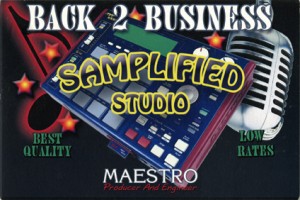
promotional card from the Samplified Digital Recording Studios Records
The growth of the Houston Hip Hop collections at the University of Houston continues as Special Collections is happy to announce the completion of a preservation project linked to the Samplified Digital Recording Studios Records.
Founded in 1990 by Philadelphia native Keenan “Maestro” Mosely (also known as Keenan Lyles, professionally), Samplified Digital Recording Studios hosted some of the biggest names in local and national hip hop. While artists like Run-DMC, Ice T, and Master P were known to record at Samplified in their visits to Houston, the archive itself documents local artists like DJ Screw, 20-2-Life, and Point Blank who recorded there.
As the finding aid illustrates, the Samplified Records contain photographs, posters, invoices, and multi-track Alesis Digital Audio Tapes (or ADATs) spanning the brief, high-impact period of the late 1990s Houston hip hop scene. Complementing the recent announcement regarding the publication of the vinyl catalog DJ Screw used to shape the genre of chopped and screwed, the Samplified Digital Recording Studios Records hold several sets of tapes containing master recordings of DJ Screw. Julie Grob, curator for our Houston Hip Hop collections, has overseen the preservation of these highly fragile and at-risk ADATs, and in the future will be able to provide scholars and fans an opportunity to hear the individual tracks via listening copies in the Special Collections Reading Room.
We invite you to explore the rest of the Samplified Digital Recording Studios Records and all of our Houston Hip Hop collections during our normal research hours. Those interested in consulting with the listening copies from the recent ADAT preservation project should contact the curator of our Houston Hip Hop collections.
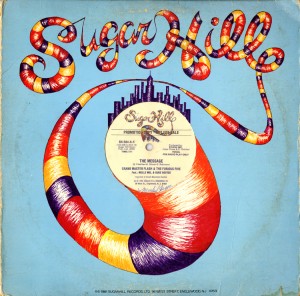
“Don’t push me cause I’m close to the edge…” | Cover of Grandmaster Flash & the Furious Five’s iconic “The Message” (1982), from the DJ Screw Sound Recordings
The University of Houston Special Collections is proud to announce the completed inventory of over 1,500 vinyl records in the DJ Screw Sound Recordings. The product of successful collaboration and hours of meticulous cataloging, this accessible online inventory marks another major step in providing future scholars intimate access to the birth of a hip hop sub-genre that is distinctly Houston.
In the early 1990s, in reaction to the East Coast/West Coast false dichotomy that had gripped hip hop, Southern hip hop grew in popularity as an alternative and cities like Memphis, Atlanta, and Miami became known for a unique sound marked alternately by intensity, bass, energy, speed, volume, and a rapid-fire lyric delivery. However, hip hop proved to be dynamic in its evolution as a new branch of sound emerged in Houston. DJ Screw (Robert Earl Davis, Jr.), the Screwed Up Click, and others gave birth to a style of hip hop that eschewed the lure of rapid beats-per-minute associated with the hyperactive, crunked-up Deep South and, instead, utilized the techniques of slowing a song’s tempo (screwing) while looping or repeating vocals or other elements (chopping) atop the new slow, surreal beat.
The result, chopped and screwed, reflected the more laid-back energy of H-Town, evoking the meandering bayous that trace the city’s sprawl and slow-moving slabs cruising the city streets.
Throughout the 1990s, as the music of DJ Screw and his collaborators rose in popularity, that unmistakable sound blaring at just a slow crawl spread quickly throughout the region, influencing the rest of Southern hip hop and diversifying the sound of the Third Coast. The untimely death of DJ Screw in 2000 seems to have only cemented the link between the artist, genre, and the city known affectionately as Screwston.
This inventory of the vinyl records in the DJ Screw Sound Recordings, the tools of an artist who managed to carve out a new niche in hip hop, is now available online and reveals the wide range of palettes with which Screw worked. The collection includes primarily Houston, Southern, and West Coast hip hop, but also holds a good amount of R&B as well as scattered recordings from genres like rock and jazz. While the majority of recordings are the 12″ singles which were used by DJs, there are also a number of albums to be found.
We invite you to trace the origins of chopped and screwed by perusing the catalog (try sorting by recording artist, or, if you prefer a more chronological view, by the record’s release year, beginning with Marvin Gaye’s 1972 “Trouble Man,”). Those interested in viewing the DJ Screw Sound Recordings may do so in our reading room, open to the general public during our normal research hours. While our policies regarding preservation do not allow us to play these records for patrons, we invite you to visit us and view the vinyl that gave birth to those famous grey tapes.
